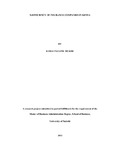| dc.description.abstract | This paper sought to determine the X-efficiency of insurance companies in Kenya and to establish whether the X-efficiency of these insurance companies is affected by market share, cost of debt and firm size. The data set consists of annual operation costs of insurance industry and commissions. Total capital and reserves, underwriting provisions and debt capital are the inputs, and claims incurred and bonuses are the outputs. The data was collected from 36 insurance companies for the period from 2005 to 2009.
To measure the X-efficiency level of insurance companies in Kenya, the study used the Stochastic Econometric Cost Frontier Approach which involves the estimation of the cost function and the derivation of the X-efficiency estimate based on the deviation from the efficient cost frontier respectively. The empirical results obtained showed that X-efficiency exists in the insurance companies in Kenya and that the X-efficiency of the insurance companies is affected by market share, cost of debt and size of the insurance company.
The level of mean X-efficiency of insurance companies in Kenya was found to be 100%. After controlling for scale differences, the average small insurance company was found to be relatively less inefficient than the average large insurance company. Large insurance companies were found to be generally more inefficient recording a mean X-efficiency of 139% compared to a mean X-efficiency of 57% recorded by the small insurance companies. The efficiency of insurance companies by organization type was also measured. Insurance companies specializing in either of life or non-life were found to be more efficient than the insurance companies operating both lines of business. Insurance companies handling both the life and non-life lines of business were found to be more inefficient with a mean X-efficiency score of 139% compared to the companies specializing in either life or non-life that recorded mean X-efficiency scores of 89% and 72% respectively. These findings are consistent with the results found in other related studies in the such as those by Cummins et al.,(1996), Rai (1996) and Fenn et al.,(2006). These findings also support the existing regulation requiring the separation of life and non-life classes of business.
The variables of cost of debt, market share and organizational size were found to affect the cost efficiency insurance companies in Kenya. The study also considered the effect of increased regulation, inflation and fraudulent settlement of claims and these were found to increase the costs of insurance companies. Increased monitoring and adoption of the risk based supervision are expected to increase the efficiency of insurance companies in Kenya. | en |

